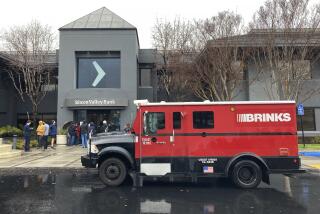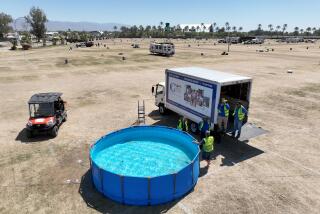Way-Worse Traffic Is the Westside Downside
Customers calling in for their pizza deliveries from the Domino’s in Westwood typically live within a mile or two of the parlor.
But these days, Domino’s drivers say they often endure wicked traffic from the moment they leave the store, turning what once was a quick delivery into a 30-minute, and sometimes a 45-minute, ordeal.
“They usually want to carry two to three more orders because it takes so long,” said Domino’s manager Arnulfo Fernandez, adding that the eatery won’t let them for fear of robberies.
“So they suffer with the tip money they’re losing,” he said.
Westside traffic has always been bad, but Fernandez, 18, is convinced that “it has gotten worse.”
Though communities around Southern California struggle with traffic problems, transportation experts and government officials agree that there is nowhere quite like the Westside, where rapid development and a boom in entertainment-related jobs have brought congestion on streets and freeways to new levels.
“Most people in Westwood cope by running errands in the morning,” said Laura Lake, a longtime community activist and slow-growth advocate. “In the afternoon, it will take twice as long.”
Population on the Westside has jumped 23% since 1990 (compared with a 6% increase for Los Angeles as a whole).
But experts say the biggest culprit in rush-hour traffic snags is a boom in Westside commercial development that has lured and created jobs.
Job growth has transformed the area into the region’s premiere commercial hub, second only to downtown Los Angeles in the number of jobs. Each day, workers pour into office buildings lining busy corridors such as Wilshire Boulevard, the burgeoning towers of Century City and the rows of Santa Monica office parks that have become a mecca for media companies such as Yahoo! and MTV.
One problem: Primarily because housing is so expensive, only about 30% of these workers actually live on the Westside, according to a Los Angeles County Metropolitan Transportation Authority study. That leaves more than 300,000 people a day commuting to the area.
So many workers drive to Santa Monica from other parts of the region that the city’s population nearly doubles during the day, to 150,000 from 87,000 at night. Beverly Hills’ population more than triples, said David Mieger, director of Westside planning for the MTA.
After the early-1990s recession, communities sought out new industries and employers to boost their local economies.
“It’s a case of be careful what you wish for,” said Hasan Ikhrata, the transportation expert at the Southern California Assn. of Governments. “With jobs and population comes more traffic and more air-quality problems.”
And further growth is coming. The MTA projects that the Westside’s population will jump by an additional 15% and jobs by 23% in the next 15 years.
The Westside building boom is the biggest since the 1980s, with high-rise condos slated for Century City and Beverly Hills and clusters of development planned for Marina del Rey and Playa Vista.
The federal government has even talked of building a nearly 1-million-square-foot FBI headquarters at the Federal Building site on Wilshire and developing some of the open land on the nearby Westwood Veterans Affairs campus.
Already, the Westside’s job growth has turned some long-standing commuting patterns on their heads.
Take the Santa Monica Freeway. For decades, the challenge during the morning rush period was getting to downtown Los Angeles from the Westside. Now, the far tougher commute goes in the opposite direction as workers struggle each morning to go west from points east, where housing is more plentiful and affordable.
According to the association of governments, an average of 227,026 vehicles drove past the Bundy exit of the Santa Monica Freeway each day in 2005, an increase of about 14,000 cars in just five years.
Samantha Culbert was one of those east-to-west commuters.
After she got married and moved to Mt. Washington from Santa Monica, the stress of commuting to her Westwood job quickly got to her.
Going from a 20-minute drive to a 90-minute schlep “took a real toll on me both mentally and physically,” Culbert said. “The traffic was bumper to bumper on the 10. If I took side streets -- going through Beverly Hills or so forth -- it was just as bad as the freeway. Olympic was congested, Beverly Boulevard, 3rd Street, Santa Monica, Wilshire.”
While spending three hours a day commuting, Culbert gained weight and became lethargic and “grouchy.” To save time, she did her grocery shopping on her lunch hour, stashing perishables in a cooler that she kept in her car.
She finally quit her job and now is director of public affairs for Kaiser Permanente Los Angeles Medical Center in Los Feliz, happily commuting 20 minutes each way once again.
The Santa Monica Freeway is far from the only problem.
Traffic on the San Diego Freeway has increased even more: to 268,126 vehicles per day at the Culver Boulevard exit in 2005, up from 246,273 per day in 2000.
Then there is Wilshire Boulevard, which the MTA has declared the busiest road in Los Angeles County. MTA research shows that during the evening rush, it can take as long as 19 minutes to drive just one mile of Wilshire near the San Diego Freeway.
MTA analysis has identified numerous Westside intersections where traffic is worsening. Among those at the top of the list: Venice Boulevard and Overland Avenue, Sunset Boulevard and Pacific Coast Highway, and Sunset Boulevard and Chautauqua Boulevard, where traffic has increased 38% since 1999.
“If there isn’t gridlock due to heavy traffic, there’s gridlock due to detours and construction projects,” said architect Howard Lichtman of Culver City. “Wherever you want to go, it’s taking longer than you expect.”
Traffic delays prompted Lichtman, owner of Lichtman Design & Construction, to stop accepting all but big construction jobs in the San Fernando Valley. “At one time, you used to be able to drive to the Valley in 30 minutes,” he said. “Now it can be twice that .... It means half a day to get out there and back.”
David Botwinick, president of Kater Litho in Hollywood, allows his drivers extra time to get across town to deliver or pick up printing jobs for Westside entertainment-industry clients.
“If my client’s screaming ‘Where’s my package?’ I say he left 35 minutes ago and should be walking through the door,” Botwinick said.
But when he calls the driver on the company’s two-way communication system, he inevitably finds that the guy is stuck in traffic.
Fixes for the tie-ups are few and far between.
Mayor Antonio Villaraigosa has vowed to improve traffic flow by more aggressively towing cars parked illegally during rush hour.
Santa Monica officials have added 1,000 affordable and market-rate housing units in the downtown area, hoping to get workers to move closer to their jobs or buses. Officials in the seaside community acknowledge a severe jobs-housing imbalance but say the problem pervades the region.
The Westside is the most densely populated area in Los Angeles without a light rail or subway line. That will change if the MTA moves forward with plans to build the Expo Line from downtown to Culver City.
“The Exposition on a dedicated right-of-way would provide a meaningful alternative to being choked in traffic on the 10,” said Kate Vernez, an assistant to Santa Monica’s city manager. “It’s a combination of mass transit along key corridors and mixed-use development. That seems to be a winning scenario.”
But most transit experts say the Expo Line alone is not enough, in part because it would run well south of the most densely populated areas.
The answer, they believe, lies in finally building a long-discussed subway under Wilshire from Koreatown to Santa Monica. Villaraigosa has said building the subway is one of his top priorities.
But the idea faces many challenges, including some community opposition, lingering concerns about methane gas and, most daunting, the hefty price tag. The cost of subway construction is estimated at $300 million to $350 million a mile. It’s roughly 13 miles along Wilshire from the subway’s current western terminus at Western Avenue to the beach.
For now, commuters are learning to live with the backups.
Renee Travlos skips breakfast some mornings to begin the half-hour commute from her Fairfax district home to her job as office manager for a law firm near Brentwood.
If she leaves later than 8:15, her drive time doubles and she’s late for work.
Travlos’ nearly seven-mile drive takes anywhere from half an hour to an hour or more, including 20 minutes to travel the mile between the Santa Monica Freeway and her Barrington Avenue office.
In her previous job, Travlos, 35, drove seven miles in the opposite direction -- along Olympic Boulevard into downtown Los Angeles -- in a mere 20 minutes.
“It was no problem,” she said.
Times staff writer Jean Guccione contributed to this report.
*
(BEGIN TEXT OF INFOBOX)
More employment, more traffic on the Westside
Traffic experts say the explosion in job growth on the Westside over the last two decades has worsened the region’s traffic. Only 30% of Westside workers live there, meaning more than 300,000 people commute into the area daily.
1) Wilshire Boulevard near the San Diego Freeway
During rush hour, it can take up to 19 minutes to drive a mile along the street.
2) Santa Monica Freeway at Bundy Drive
An average of 227,026 vehicles a day drove past the junction in 2005, an increase of about 14,000 since 2000.
3) San Diego Freeway at Culver Boulevard
An average of 268,126 vehicles a day drove past in 2005, an increase of almost 22,000 since 2000.
4) Lincoln at Manchester
26,000 vehicles during daily rush hour in 1999; 30,345 in 2005.
5) San Diego Freeway at La Tijera Boulevard
An average of 288,000 vehicles a day drove past in 2005, an increase of about 10,000 since 2000.
*
Sources: Westside Cities Council of Governments, Southern California Assn. of Governments, Metropolitan Transportation Authority
More to Read
Start your day right
Sign up for Essential California for news, features and recommendations from the L.A. Times and beyond in your inbox six days a week.
You may occasionally receive promotional content from the Los Angeles Times.







